|
Getting your Trinity Audio player ready...
|
With each sharp turn, the winding road leads travelers through the rugged and untamed landscape of Northwestern Montana. As we ascend through the vast mountains, the true essence of Glacier National Park reveals itself – a wild and wondrous adventure waiting to be explored.
Overview
As the first hints of spring emerge, brave workers embark on a daunting task – clearing up to 80 feet of snow from Going-to-the-Sun Road. It’s an arduous two-month journey, but the rewards are priceless. Once the road is open, adventurers flock to Glacier National Park, eager to bask in the ever-changing landscapes and breathtaking vistas. It’s easy to see why the park was deemed the Crown of the Continent by its founding father – it truly is the ultimate adventure destination.
The road is called Going-to-the-Sun Road, named after the majestic peak known as Going-to-the-Sun Mountain. This prominent mountain can be seen to the east as you drive past Logan Pass. According to one Native American legend, a deity known as Sour Spirit descended from the sun to teach the Blackfeet tribe how to hunt. As Sour Spirit returned to the sun, an image was left on the mountain as a symbol of inspiration for the tribe.
The rugged road, the first to be registered as a National Historic Place, National Historic Landmark and Historic Civil Engineering Landmark, stretches for 50 miles (80 km) across the vast expanse of the park. It winds through treacherous terrain, revealing breathtaking views at every turn, as it connects the east and west entrance stations.
Experience the majesty of Going-to-the-Sun Road with our Explorer’s Guide. Each curve and bend reveals a breathtaking display of rugged wilderness in Northwestern Montana. As we climb higher, Glacier National Park unveils its true magnificence – an untamed wonderland calling for daring explorers to embark on an unforgettable journey.
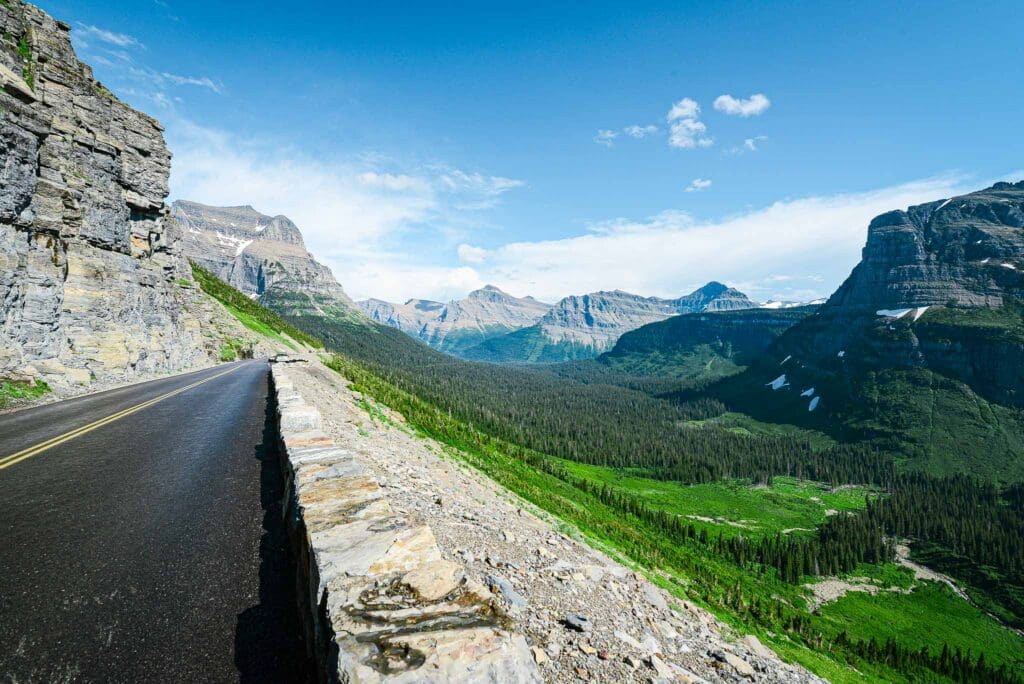
View of mountains from the Going-to-the-Sun Road at Glacier National Park.
Please be aware that as of now, a reservation and ticket are required to travel the Going To The Sun Road in Glacier National Park. This may affect your plans for your trip.
Table of Contents:
Article Navigation: Click on any of the listed items in the table of contents below to jump to that section of the article. Similarly, clicking on any large, white section header will jump you back to the Table of Contents.
- Overview
- History and Design
- Repairs and Maintenance
- Apgar Visitor Center
- Lake McDonald
- Trail of the Cedars
- West Tunnel
- Garden Wall
- Bird Woman Falls
- Weeping Wall
- Triple Arches
- Logan Pass
- Jackson Glacier Overlook
- St Mary Lake
History and Design
The treacherous road cuts through the heart of the mountains, aptly named Going-to-the-Sun Road after the towering summit looming in the distance. As one drives past Logan Pass, they can catch a glimpse of this majestic peak to the east. Native American legends speak of Sour Spirit, a powerful deity who descended from the sun and gifted the Blackfeet tribe with the knowledge of hunting. As he ascended back to his celestial home, he left an enduring image on the mountain as a symbol of strength and inspiration for generations to come. Some believe it was a European explorer who first gave the mountain its name and attached it to the Native American legend, forever intertwining myth and reality in these rugged lands.
Glacier Route 1 Road, more commonly known as Going-to-the-Sun Road, was one of the first National Park Service initiatives designed to cater to tourists traveling by car. It was originally proposed by superintendent George Goodwin in 1917, who then became the chief engineer for the Park Service in the following year. The road starts at U.S. Route 2 in West Glacier, Montana and ends at U.S. Route 89 in St. Mary.
The Going-to-the-Sun Road is a narrow and winding two-lane road, with sharp turns and hairpin curves, especially on the west side of Logan Pass. As a result, vehicles longer than 21 feet (6.4 m) and wider than 8 feet (2.4 m) are not permitted to travel on the highest sections of the road between Avalanche Creek and Rising Sun picnic areas, which are located several miles below Logan Pass on both sides. Vehicles taller than 10 feet (3.0 m) may also face clearance issues due to overhanging rocks when driving west through the Loop hairpin turn. Speed limits along the road vary, with maximum speeds of 45 mph (72 km/h) in lower elevations and 25 mph (40 km/h) in steeper and more winding sections in the alpine region.
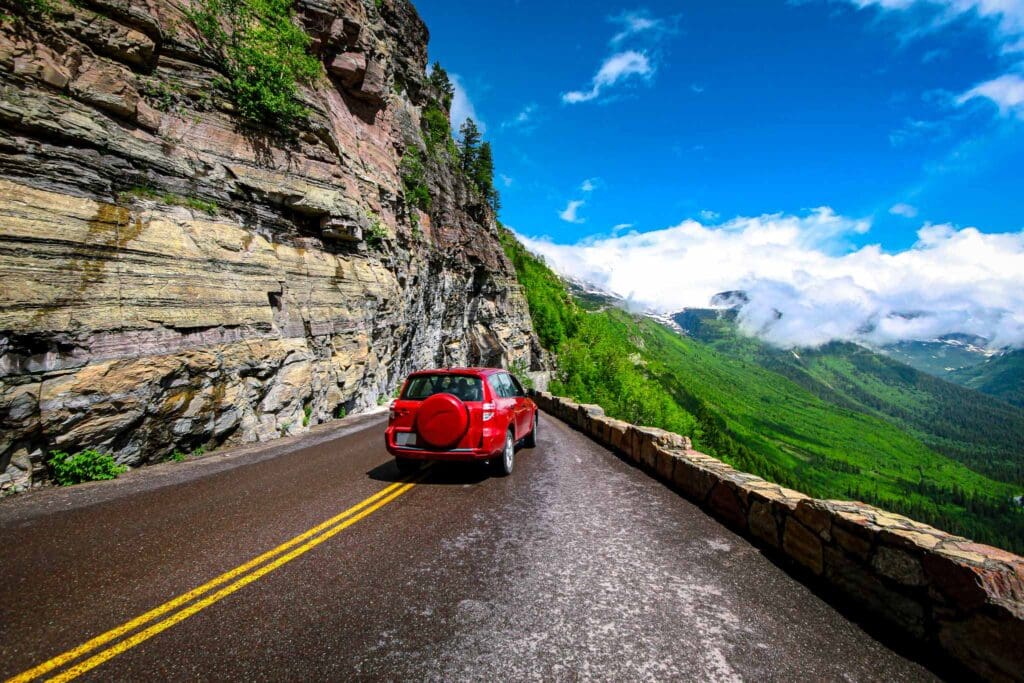
Going-to-the-Sun Road
Drive safely! When driving on mountain roads, please be cautious and take necessary precautions. It’s always a good idea to have a map downloaded before you start your journey in case you enter areas with no cell service. In the winter, make sure your vehicle is equipped with snow tires or chains. And if you want to take a moment to appreciate the beautiful scenery or check your map, find a safe spot to pull over out of the way of other drivers.
Repairs and Maintenance
During springtime, the road that runs through North America is notorious for being one of the most challenging roads to clear of snow. Up to 80 feet of snow can accumulate on Logan Pass, also known as the Big Drift, making it incredibly difficult for snowplow crews to make a dent in its massive depths. Even with heavy-duty equipment capable of moving thousands of tons of snow in an hour, it takes about ten weeks to fully plow the road. On the east side of the Continental Divide, there are minimal guardrails due to frequent avalanches caused by heavy snowfall, making it even more treacherous for drivers. The road is typically only open from early June to mid-October, with the latest recorded opening date being July 15th, 2022 – a record-breaking delay since its initial opening on July 15th, 1933.
The National Park Service and the Federal Highway Administration have been collaborating on a restoration project to repair damage caused by avalanches and rock slides throughout the years. This ongoing project, which began in the 1980s, focuses on fixing retaining walls, replacing original pavement with reinforced concrete, and conducting maintenance work on tunnels, bridges, culverts, and overlooks when weather conditions allow.
Apgar Visitor Center
Immerse yourself in the wonders of Glacier National Park by starting your journey at the Apgar Visitor Center, which serves as a gateway to all your adventures in the park. Here, seasoned park rangers stand ready to guide you on your journey and help you plan your day filled with exhilarating hikes, breathtaking views, and unforgettable memories. Leave your car behind and embark on an epic adventure by hopping on the complimentary shuttle or board a private tour bus, which will take you to various locations along the iconic Going-to-the-Sun Road.
Concessionaire-operated Sun Tours and Red Bus Tours will also operate in the west side of Going-to-the-Sun Road. To make reservations with Sun Tours, visit their website. For Red Bus Tour reservations, visit Glacier National Park Lodges’ website.
Lake McDonald
As you wind through 10 miles of dense forest, keep your eyes peeled for glimpses of Lake McDonald. Its crystal blue waters beckon you deeper into the wilderness, a thrilling gateway to an unforgettable experience in the heart of the mountains.
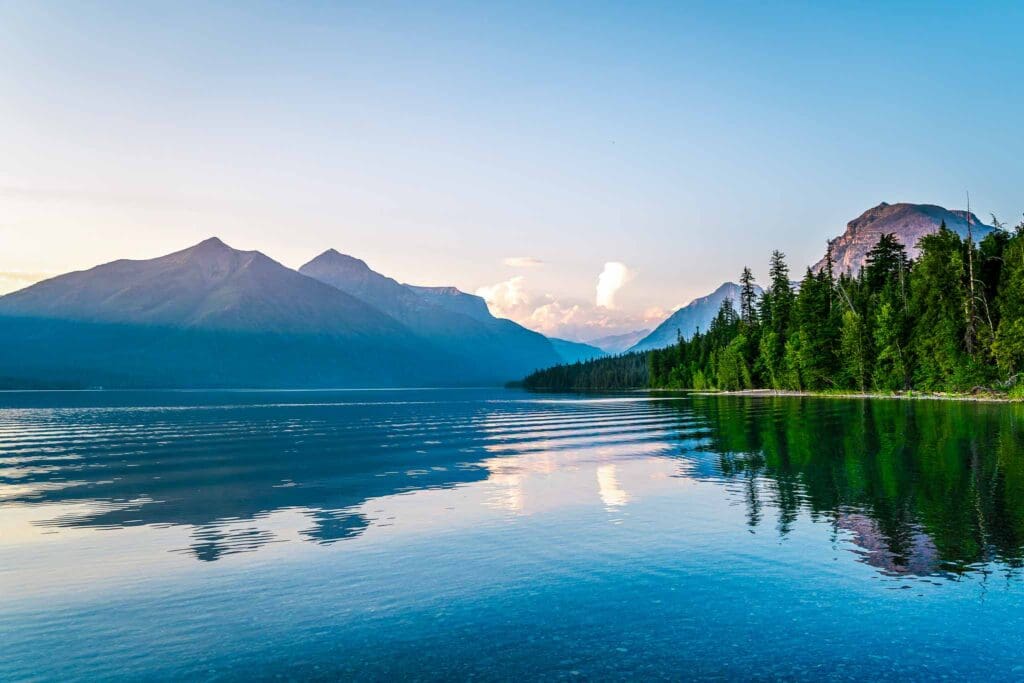
Sunset over Lake McDonald in Glacier National Park in Montana.
Easing away from the tranquil lake, the winding road weaves through a dense forest of majestic mountain hemlocks and towering red cedars. As it climbs alongside McDonald Creek, the sound of rushing water intensifies, leading to a breathtaking view of McDonald Falls. The cascading waters create a symphony of nature, echoed by the echoing rumble around us. Just ahead lies a lush marshland, home to graceful moose who frequent its waters in search of succulent aquatic plants. These magnificent creatures, often weighing over 1,000 pounds, are skilled swimmers, gliding effortlessly through the crystal-clear ponds that reflect the surrounding greenery. It’s a peaceful scene that reminds us of the incredible harmony between man and nature.
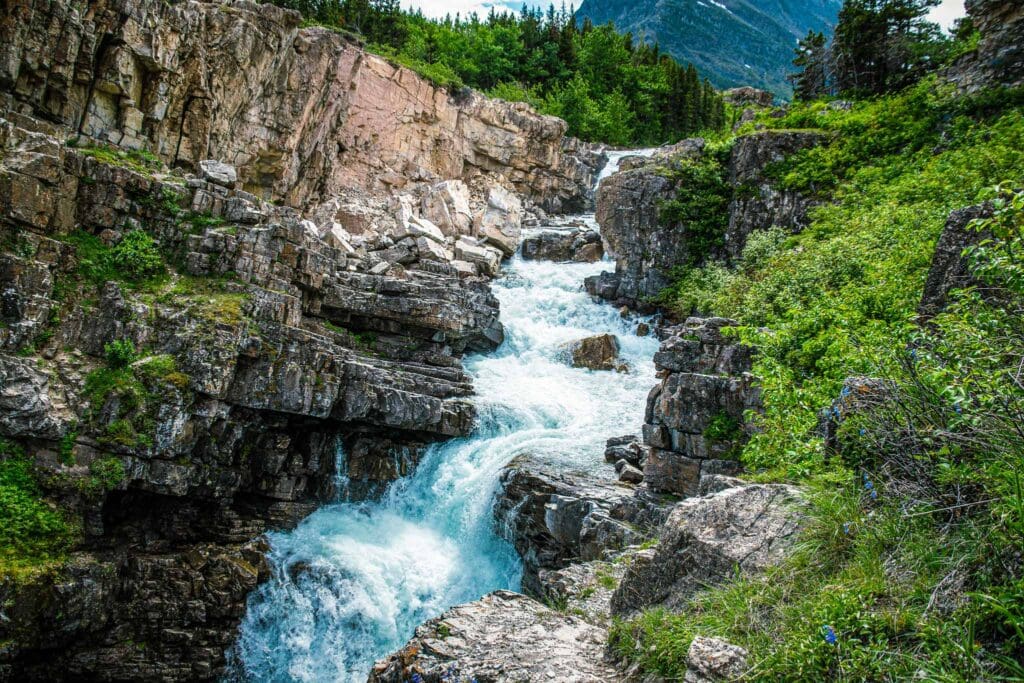
McDonald Falls is one of several breathtaking waterfalls along the Going to the Sun Road.
Trail of the Cedars
Embark on the Trail of the Cedars, a beloved and accessible hike in Glacier National Park, Montana. This one-mile loop winds through lush forests and offers stunning views of Lake McDonald. Whether you are an experienced hiker or just starting out, this trail is perfect for all abilities. And for those seeking even more excitement, the Trail of the Cedars serves as the entrance to the rugged and breathtaking Avalanche Lake trail. Get ready to kick off your adventure with this unforgettable hike.
The Trail of the Cedars is a gentle stroll through Glacier National Park, suitable for people of all ages and abilities. It’s perfect for families with children or seniors who want to enjoy the beautiful nature without undertaking a challenging hike. The trail spans 0.9 miles and only has a slight elevation gain of 49 feet. With its wide path and boardwalks, it’s an ideal option for those who need assistance or more time to walk. While it may seem like an easy day hike, visitors should still be cautious of potential wildlife encounters and unpredictable weather conditions, especially in the winter and early spring at Glacier National Park.
A canopy of thick moss-covered hemlocks and aromatic cedars provides a refreshing shade over the half-mile raised boardwalk that meanders through an ancient forest. The forest floor is covered in a variety of ferns and mosses, each glistening with dew. At the end of the trail, there is a faint sound of Avalanche Creek trickling through a small gorge, adding a harmonious touch to the natural symphony.
Keep your eyes open for the water ouzel, also known as the dipper. This tiny bird with its slate-colored feathers has a unique ability to walk underwater in search of food. Don’t forget to listen for the melodic calls of the varied thrush, particularly in the damp forests along the two-mile trail that leads to Avalanche Lake. As you reach the end of the path, you’ll be greeted by half a dozen waterfalls cascading down 2,000-foot cliffs and feeding into the glistening lake.
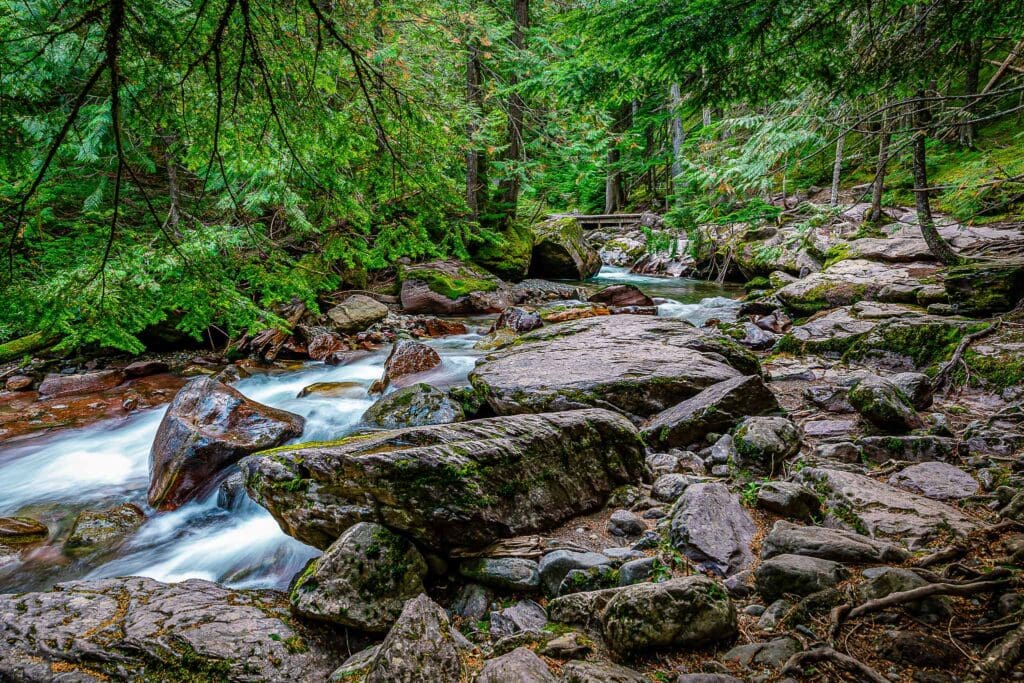
Avalanche Creek along the Trail of the Cedars in Glacier National Park.
A popular hiking spot, the Avalanche Lake Trail is known for its scenic views and moderate difficulty level. Stretching for 5.9 miles and with an elevation gain of 757 feet, it takes about 2-3 hours to complete. This trail is open all year round and offers breathtaking views of Avalanche Lake throughout the journey. The lake itself is surrounded by majestic mountains and fed by cascading waterfalls from the alpine bowl. During the warmer months, these waterfalls add an extra layer of beauty to the already enchanting location. In addition to the stunning surroundings, hikers can also appreciate the diverse range of plant life along this trail.
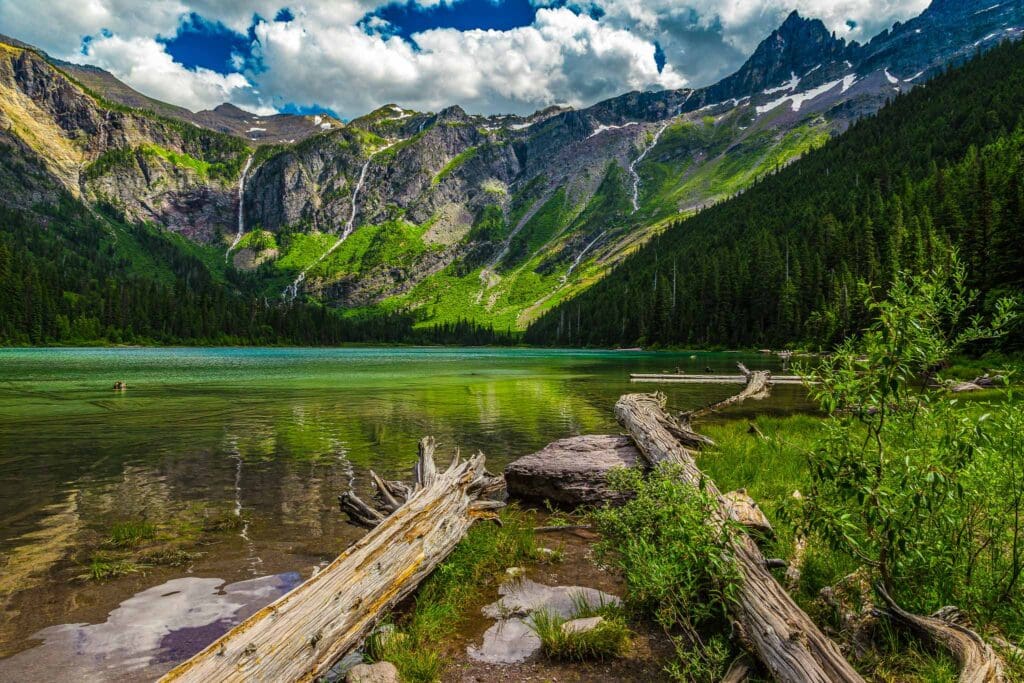
Avalanche Lake in Glacier National Park, Montana
West Tunnel
In the years of 1926 and 1927, workers built this passageway on the western side of Going-to-the-Sun road. The West Tunnel is a remarkable feat of engineering, guiding cars through a rugged cliff while also offering two viewing portals to admire Heavens Peak and McDonald Creek.
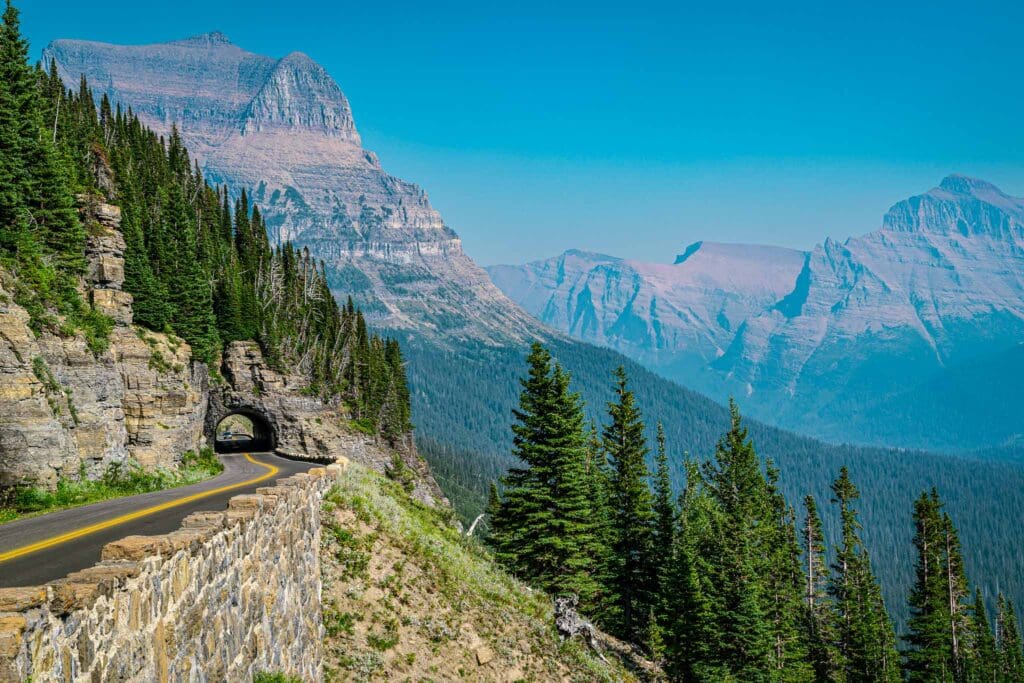
Tunnel along Going-to-the-Sun Road in Glacier National Park.
Garden Wall
The road gradually climbs higher, and the lush cedars and hemlocks thin out, replaced by scattered clusters of spruces and firs. As you continue past Red Rock Point, you can’t help but gasp as the magnificent Garden Wall comes into view. A towering ridge that reaches thousands of feet above, its jagged edge is a part of the Continental Divide. Any precipitation or streams west of this divide will eventually flow towards the Pacific Ocean, while those on the east side will head towards the Atlantic.
In 1967, a fire caused by lightning swept through the woods in this region. The once majestic trees were reduced to blackened sticks, now scattered across the hillsides. But nature is resilient, and shrubs and young pine trees are beginning to grow again, marking the return of life to this harsh, previously destroyed terrain.
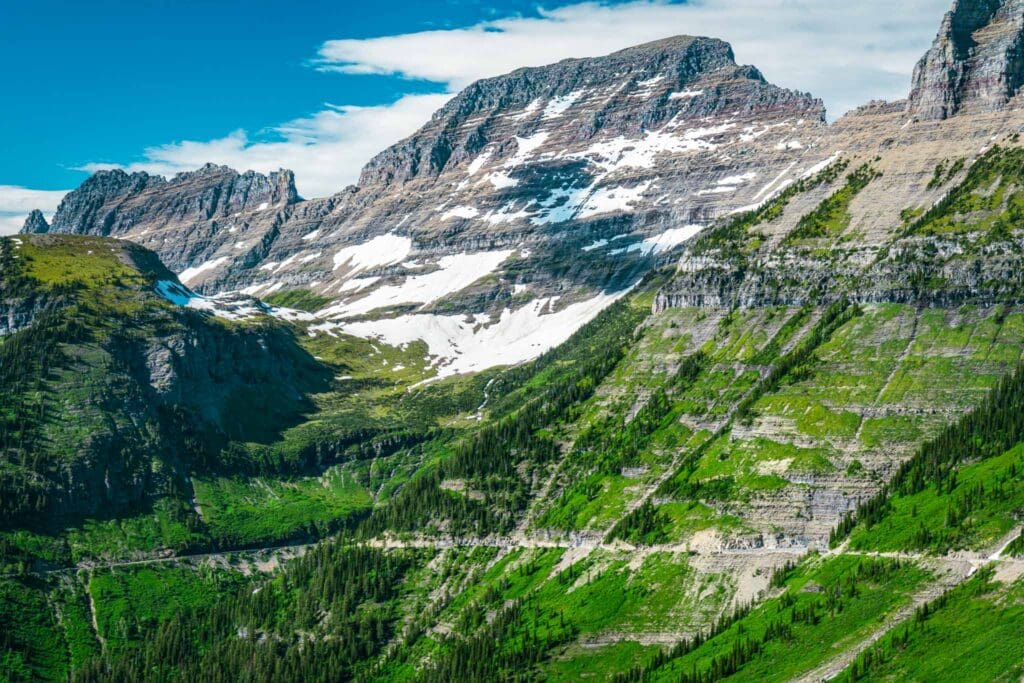
Along the Going-to-the-Sun Road along the Garden Wall.
Bird Woman Falls
As the shadows of the Garden Wall loom overhead, the winding drive snakes its way along the treacherous Loop. With each turn, the air grows thinner, and the landscape transforms into a tumultuous terrain of cascading waterfalls, towering peaks, and steep ravines. High above the treeline, in this unforgiving realm, lies one of its most magnificent wonders – Bird Woman Falls. Fed by the relentless rush of meltwaters, this cascade crashes down the mountainside in a thunderous display of raw power. And just two miles ahead awaits Weeping Wall, where several streams plummet down a jagged cliff face. Some say these cascades weep for the end of winter’s icy grip, but perhaps they are tears of defiance, heralding the triumphant return of spring.
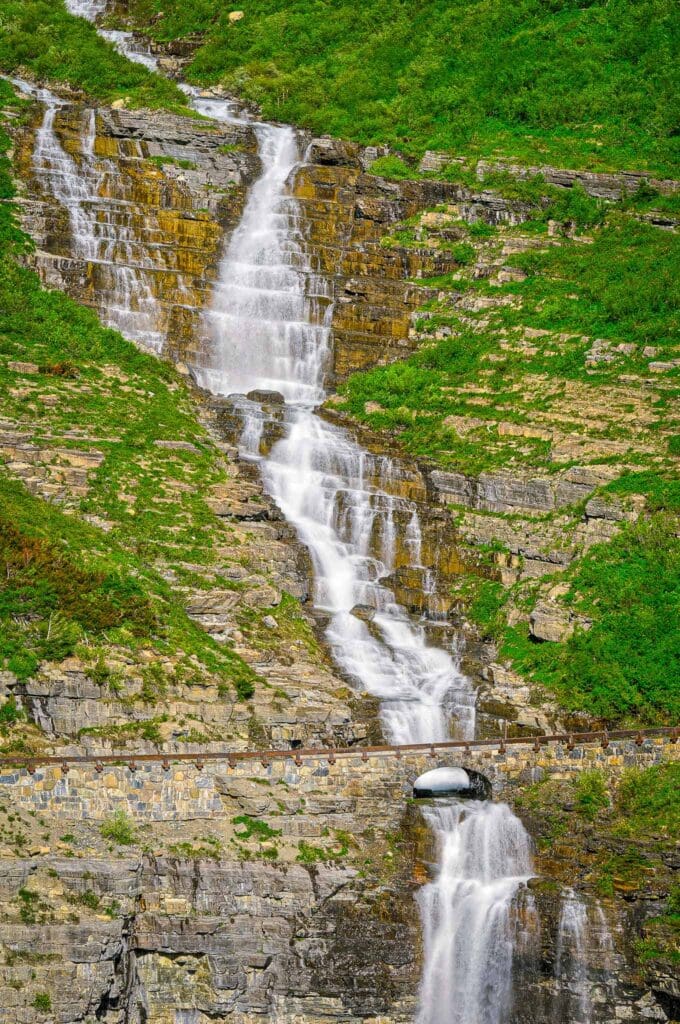
Bridge on the Going-to-the-Sun Road over the Bird Woman Falls in Glacier National Park, Montana.
Weeping Wall
Nestled along Going-to-the-Sun Road lies the magnificent Weeping Wall, a stunning geological formation. Water cascades from the side of Haystack Butte and the Garden Wall, nourished by the pure snowmelt that flows down from above. It is a breathtaking reminder of nature’s power and beauty.
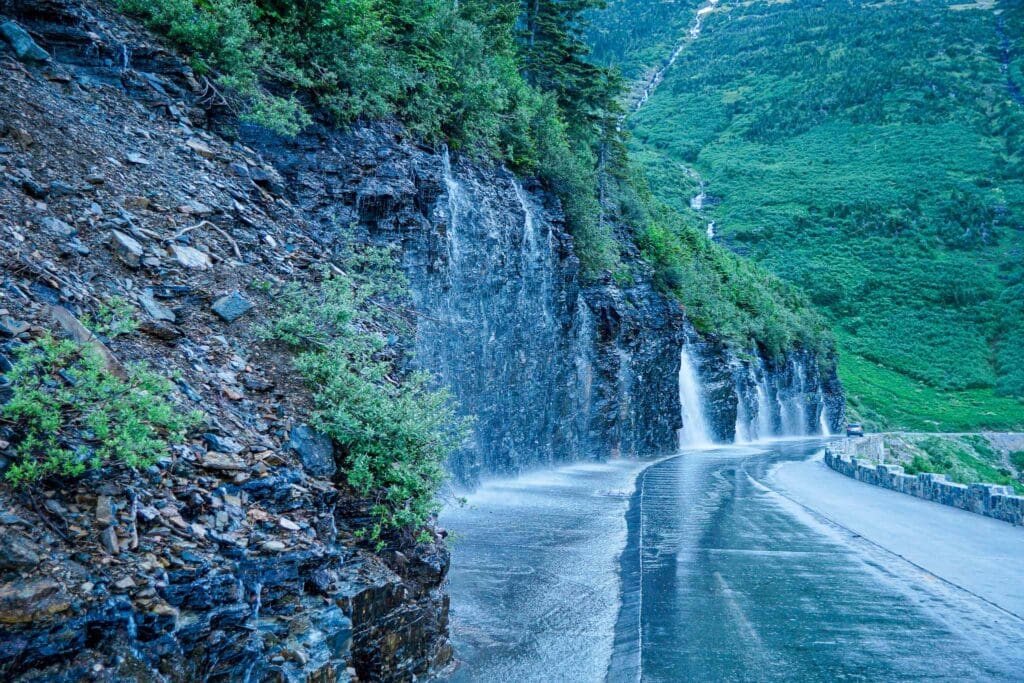
Weeping wall on the Going to Sun road in Glacier National Park.
Triple Arches
One of the most iconic landmarks on the Going-to-the-Sun road is Triple Arches. In order to bridge the large gaps in the mountainside, designers came up with an elegant solution: constructing three arches in a series.
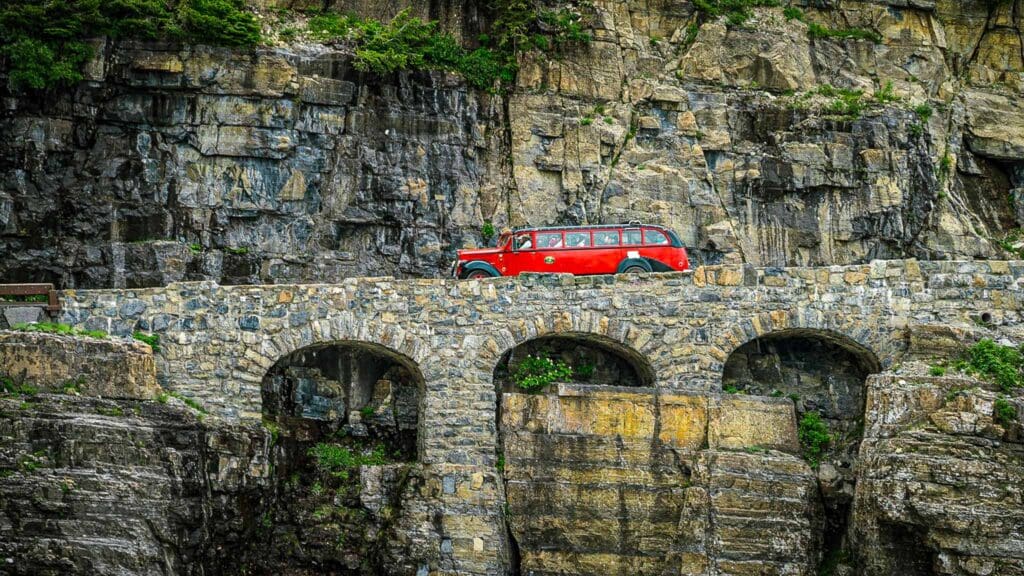
The Triple Arches. Photo: NPS
Logan Pass
The drive to Logan Pass reaches a thrilling apex at 6,646 feet. With jagged peaks and rugged terrain all around, the scenery is both breathtaking and daunting. The subalpine forest of twisted firs gives way to open slopes and meadows bursting with vibrant wildflowers – a landscape that screams adventure. Among the wonders are bright yellow glacier lilies poking through patches of snow, shooting stars dotting the hillsides, fiery Indian paintbrushes, and towering wands of beargrass topped with delicate clusters of snowy blooms bravely swaying in the breeze. This is nature at its most exhilarating and you can’t help but feel alive amidst it all.
Embark on your journey at the bustling visitor center of Logan Pass, where a multitude of trails await. Be sure to traverse the winding boardwalk that meanders through the enchanting Hanging Gardens. As you venture through Glacier National Park, be on the lookout for one of its iconic inhabitants – the majestic mountain goat, freely roaming along the rugged slopes.
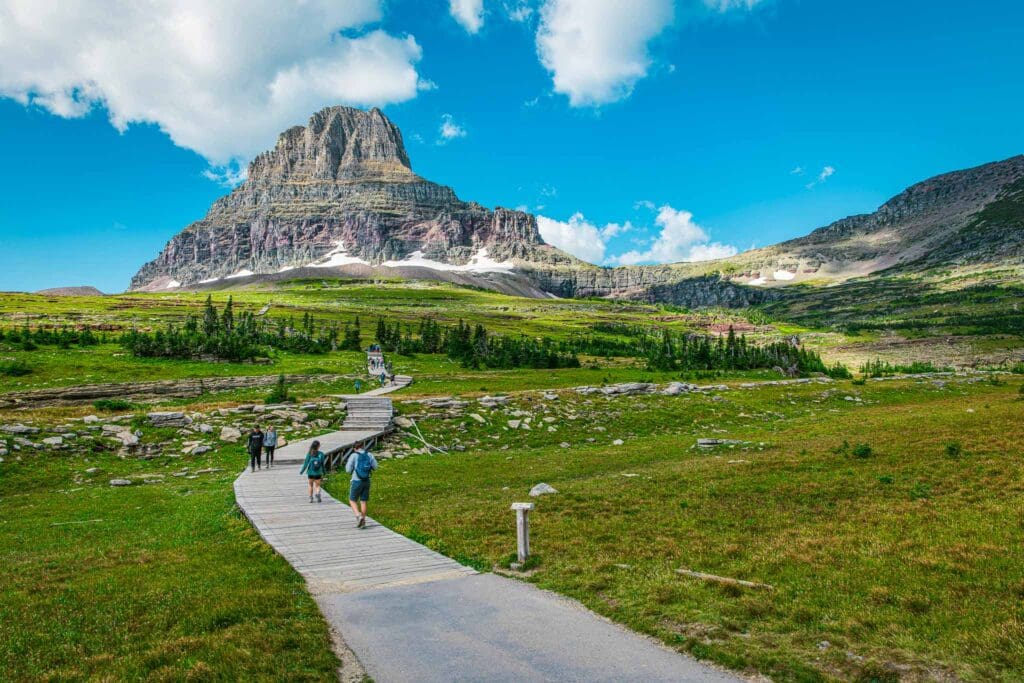
Hikers on the Hidden Lake Trail with Bear Hat Mountain in the Background at Logan Pass.
Jackson Glacier Overlook
Perched atop the rocky outcropping, the Jackson Glacier Overlook offers a breathtaking panorama of the majestic gray-blue mass. As one of the many magnificent viewpoints in the park, it serves as a gateway to the untamed wilderness that shaped this awe-inspiring landscape millennia ago. Despite its small size compared to the ancient ice-age glaciers, Jackson Glacier is a reminder of nature’s incredible power and resilience. A thrilling adventure awaits those brave enough to explore this rugged terrain.
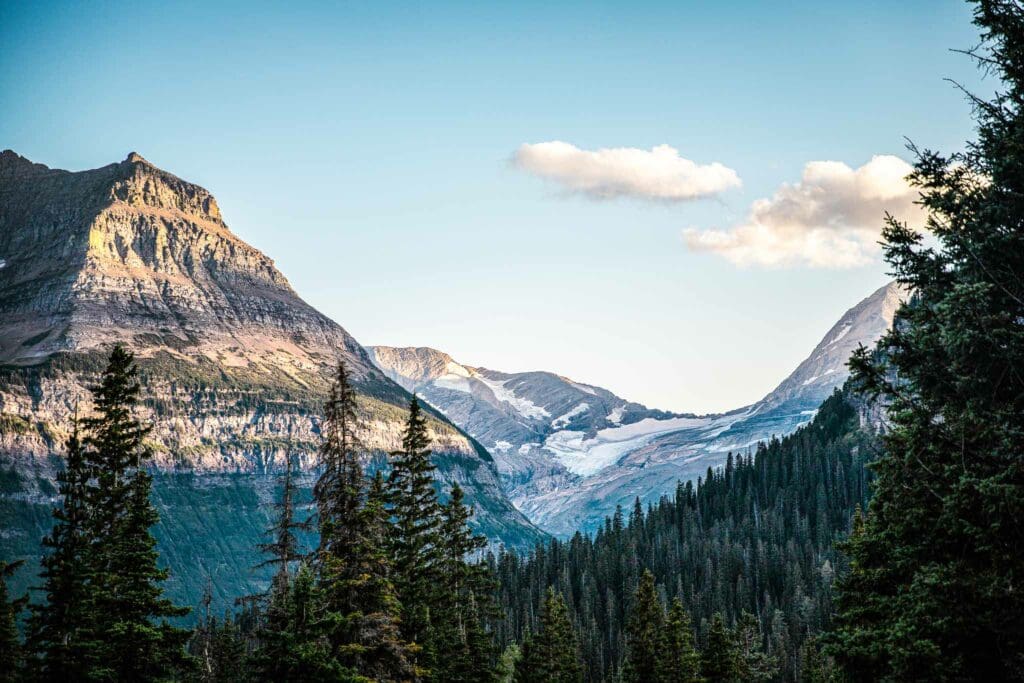
The Jackson Glacier Overlook, along the east side of Going-to-the-Sun Road is one of the easiest spots in the park to see a glacier.
St. Mary Lake
The road winds through a majestic forest of aspens, alders, and birches – their leaves vibrant green in summer, but ablaze with golden hues in the fall. As the car descends towards St. Mary Lake Valley, the air is filled with the crisp scent of pine and the promise of adventure. And when the lake comes into view, nestled amongst towering peaks reaching a mile high, it’s easy to understand why the Blackfeet people revered it as “the inside lake.” Nature’s grandeur beckons, ready to be explored.
To catch a glimpse of the rugged beauty of this mountain treasure, stop at the Wild Goose Island Overlook. Its name evokes images of wild animals roaming the land, and the little island appears to defy gravity on the serene waters of St. Mary Lake. It’s a must-see spot for any nature lover or adventure seeker.
Cresting the distance was another unusual sight, Triple Divide Peak, which formed part of the Continental Divide. One could imagine three rain drops falling on the mountain, with one flowing west toward the Pacific, another toward the Atlantic, and the third north across Canada and into the Arctic Ocean.
As you continue on, the landscape expands before you, revealing wide open spaces and fields of bunchgrass stretching out into the wilderness. Once you reach Divide Creek, you leave behind the awe-inspiring sights of the park and enter into the vast plains that lie to the east. But who knows, maybe you’ll be tempted to turn around and experience the drive all over again.
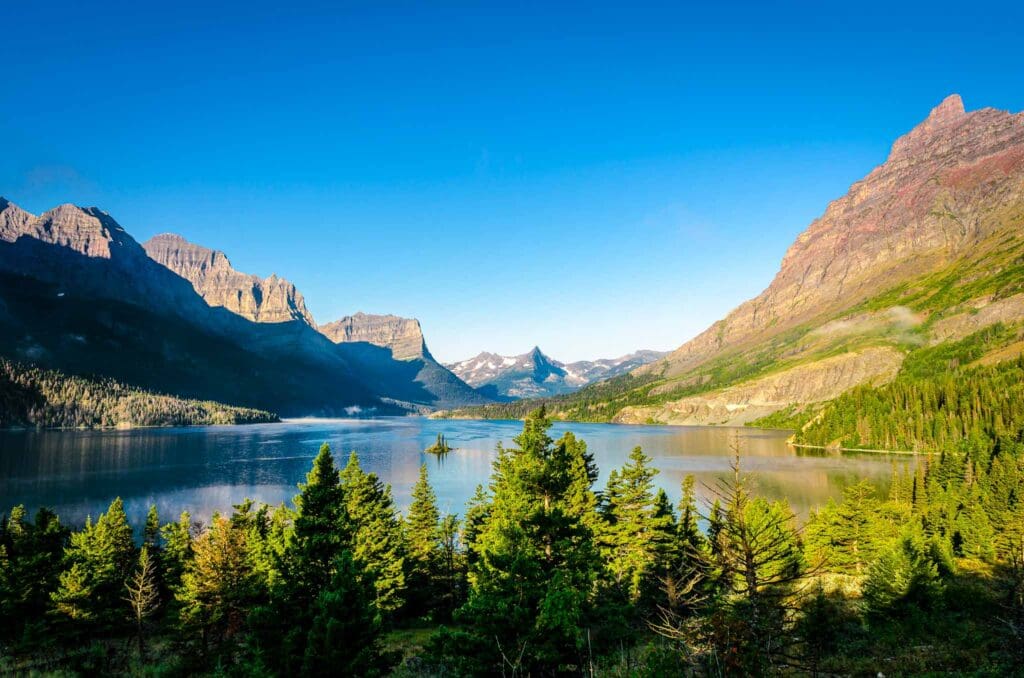
St Mary Lake with Wild Goose Island in Glacier National park, Montana
Popular Articles:
An Essential Guide to the Melting Glaciers in Glacier National Park
Adventurer’s Guide to Glacier National Park, Montana
Trail Running Essentials For Life On The Run









